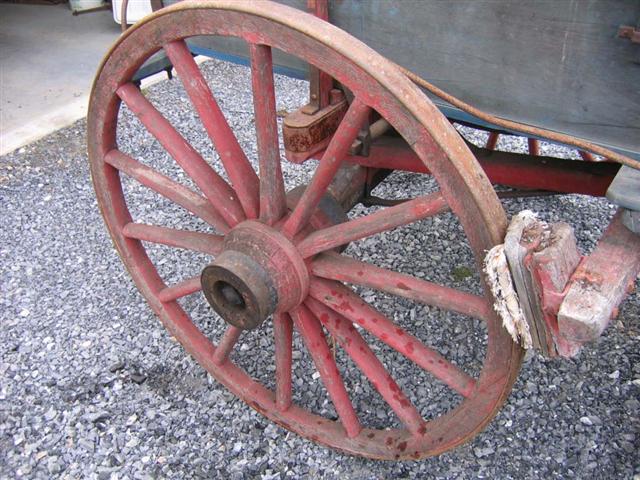
On many occasions I’ve been asked for my opinion on what I feel has been the greatest development in the way a modern bike rides. There are so many to choose from:- fuel-injection, multi-valve engines, complex suspension, the list is seemingly endless. The reality though is one function has become so good, we almost take it for granted. Brake systems.
The current sport bike is capable of incredible stopping performance from any speed, in any weather condition, and completely reliably. Your own machine may have a sophisticated anti-lock system, available now on even the smallest capacity bikes.
So, how did we get here? A little history…
The header picture shows the most rudimentary form of brake. A simple wooden block that pushes on the wheel rim when applied by the driver. How is this relevant to your twin-disc, fully floating, radial-mount caliper, ABS Yamaha R1? They work on exactly the same principle. That of friction.
Development of the earliest motorcycles came from the simple design of a bicycle. During the last few years of the nineteenth century and the very beginning of the twentieth, there was a huge explosion of new mechanical ideas and thinking. The bicycle had already been around for nearly a hundred years and was already well-developed, so these early motorcycle designs leaned heavily on existing bicycle technology, including the brakes.
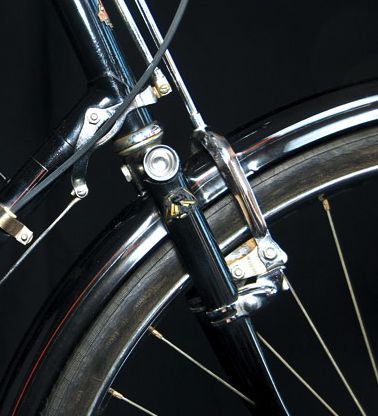
Stirrup Brakes
Here is a brake from an early British lightweight motorcycle. A Raleigh in fact. When the rider pulls the brake lever, small blocks (in this case, made of leather) are forced onto the wheel rim and everything theoretically comes to a stop. This is called a stirrup-brake. Even back in the day, these were far more suitable for bicycles than anything with a motor, so thankfully they didn’t hang around too long. The next development was so far advanced in function and design, it was the only choice right up until the early 1970’s and is still in widespread use today. The drum brake.
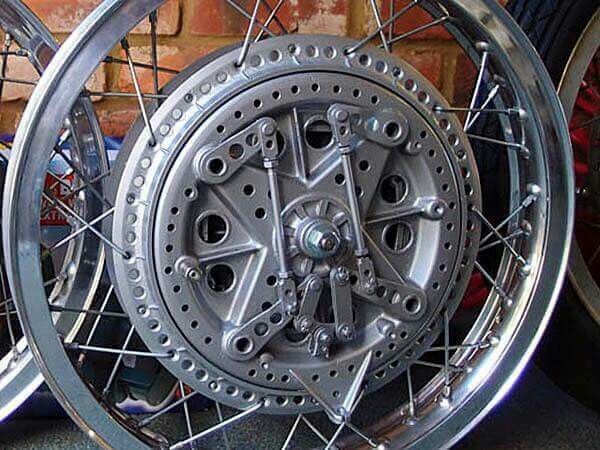
Drum Brakes
The design of the drum brake is a masterpiece of form and function. It can also be deceptively simple.
The center part of a wheel (known as the hub) is enlarged to form a hollow drum-shaped cavity. This has a lining of tough, high-friction metal, and when operated, crescent shaped spades with friction material bonded to them (know as shoes) press against the inside of the cavity. Friction is created, and with it, stopping power.
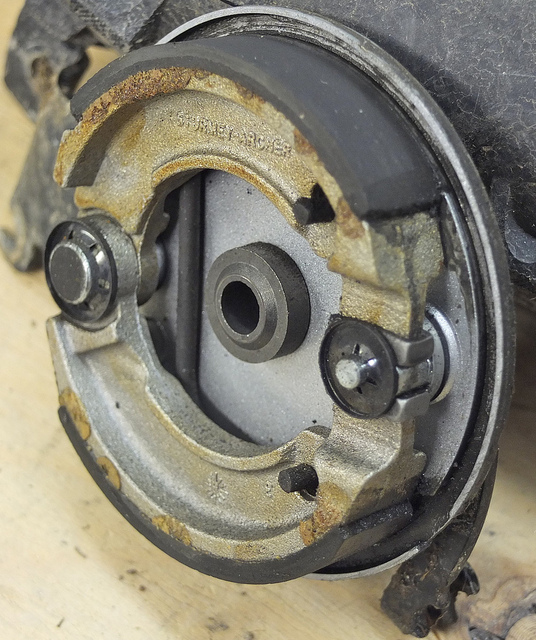
Here’s a simple drum brake mechanism. The shoes are very clear to see, as are the lining surfaces on them. To operate this brake, the lever (at the five-o-clock position in the picture) is pulled, and by means of an eccentric cam, the shoes are moved outward. A curved spring (hidden behind the shoes themselves) returns everything to where it was when the lever is released. The only thing missing from this picture is the drum itself. Everything you see here is contained within that, when the unit is assembled. This is as simple as it gets. Operation is usually by cable to a lever on the handlebar, although some manufacturers did try hydraulic operation.
The whole assembly is neat, easy to maintain, and weatherproof, and in the case of the picture of that fabulous Fontana racing brake at the beginning of this section, it can be incredibly powerful too. so why don’t we see more drum brakes on larger bikes today?
The answer is rooted in the fundamentals of how all brakes work, our old friend friction.
With friction comes a rather undesirable by-product, and that is heat. Because all the operating parts of a drum brake are contained within a hub, they are extremely prone to overheating, particularly in higher performance applications. Overheating can cause a wide variety of serious problems, including complete loss of brake power. This phenomenom is called fading or fade.
Suzuki famously fitted drum brakes to the front wheels of their new three-cylinder GT range for the 1973 model year. The other three Japanese manufacturers had already gone to discs but Suzuki insisted that a sophisticated large-diameter drum was a perfect choice for a big touring bike.
It was not.
Although prized by cafe-racer builders today, those Suzuki drums were terrible brakes. Keeping them adjusted correctly was nearly impossible and worse still, after a couple of hard applications, your front brake lever would pull all the way back to the grip. Half way through the model year, Suzuki called it quits, and retro fitted twin discs to the 750, never again returning to big drums.
This brings us full circle to where we are today, and make no mistake it was a giant revolution in every sense of the word! Disc brakes.
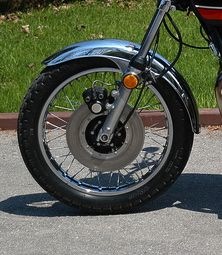
Disc Brakes
Here is a perfect example of an early disc set up. In this case, it’s Kawasaki’s legendary Z1. The year is 1973 and nearly all the major manufacturers are putting this, or something similar on the front of their big bikes. Suddenly, braking from high speed stopped being the terrifying ordeal it had been. Even the smaller manufacturers, Triumph, Norton, Moto Guzzi had jumped on the disc bandwagon. Drums still had a valuable place in motorcycling, but for high performance, their days were numbered.
Make no mistake though, these early discs were still nowhere near as powerful as today’s. There was still a long way to go, but it was a massive step in the right direction.
In part 2 , we will explore the components of your brake system, identify each one, and the part it has to play. In part 3, we will examine common problems, how to rectify them, and common sense maintenance techniques for keeping your brakes healthy . Ride Safe!
